inflation pressure CHEVROLET BLAZER 1994 2.G Owners Manual
[x] Cancel search | Manufacturer: CHEVROLET, Model Year: 1994, Model line: BLAZER, Model: CHEVROLET BLAZER 1994 2.GPages: 348, PDF Size: 17.88 MB
Page 275 of 348
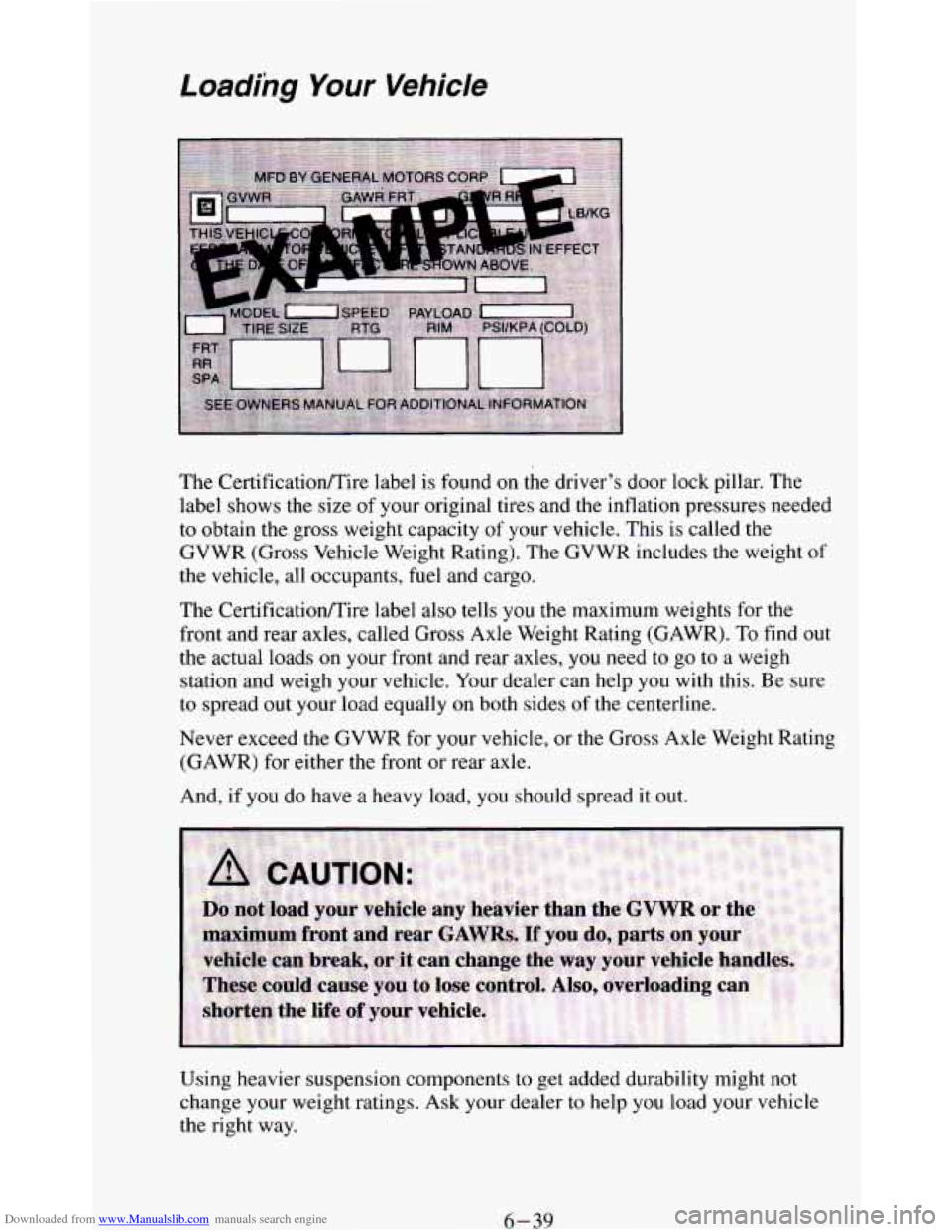
Downloaded from www.Manualslib.com manuals search engine Loading Your Vehicle
The CertificatiodTire label is found on the driver’s door lock pillar. The
label shows
the size of your original tires and the inflation pressures needed
to obtain the gross weight capacity
of your vehicle. This is called the
GVWR (Gross Vehicle Weight Rating). The GVWR includes the weight
of
the vehicle, all occupants, fuel and cargo.
The Certificationnire label
also tells you the maximum weights for the
front and rear axles, called Gross Axle Weight Rating (GAWR). To find
out
the actual loads on your front and rear axles, you need to go to a weigh
station and weigh your vehicle. Your dealer can help you with this. Be sure
to spread out your load equally on both sides
of the centerline.
Never exceed the GVWR for your vehicle, or the Gross Axle Weight Rating
(GAWR) for either the front or rear axle.
And, if you do have a heavy load, you should spread it out.
Using heavier suspension components to get added durability might not
change your weight ratings.
Ask your dealer to help you load your vehicle
the right way.
6-39
Page 278 of 348
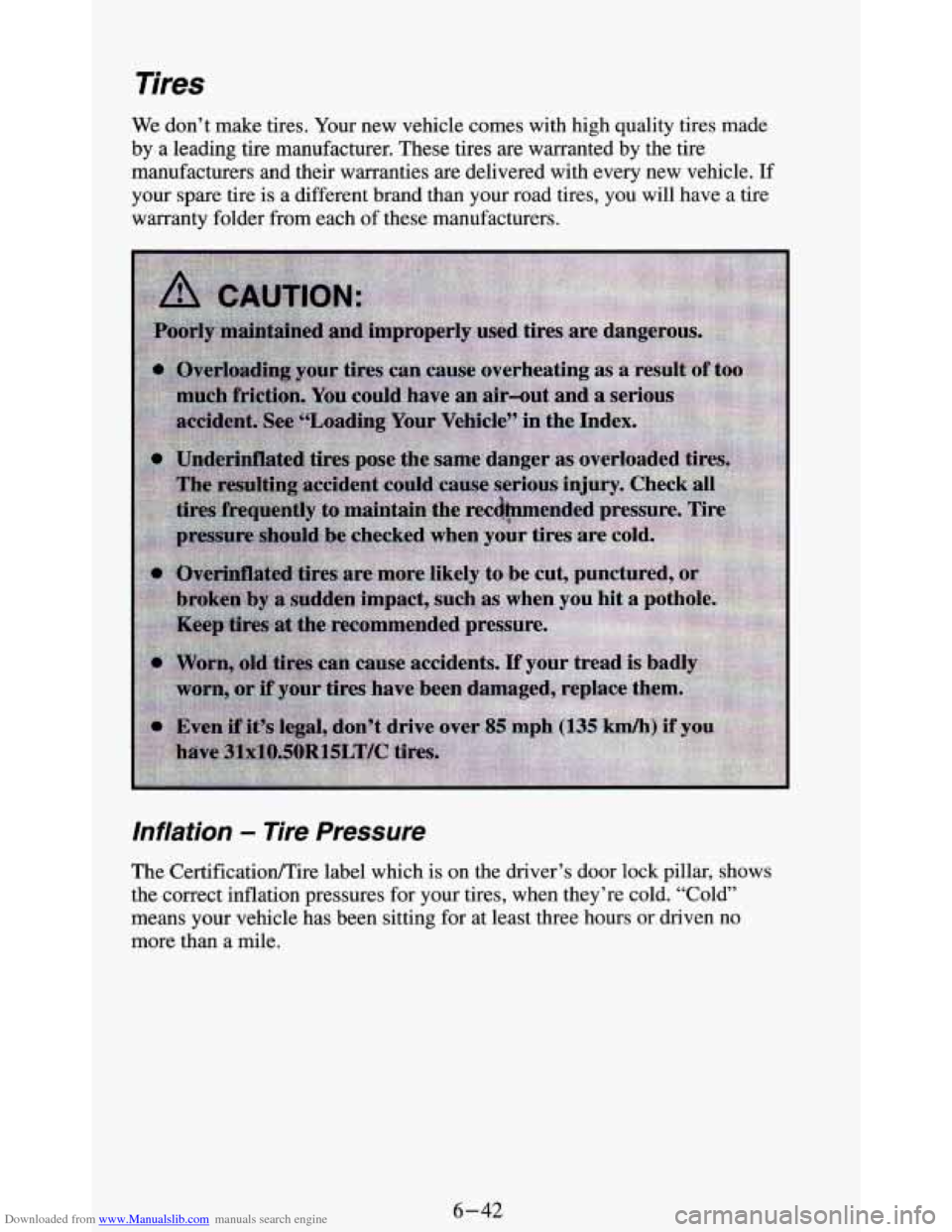
Downloaded from www.Manualslib.com manuals search engine Tires
We don’t make tires. Your new vehicle comes with high quality tires made
by a leading tire manufacturer. These tires are warranted by the tire
manufacturers and their warranties are delivered with every new vehicle.
If
your spare tire is a different brand than your road tires, you will have a tire
warranty folder from each of these manufacturers.
Inflation - Tire Pressure
The Certificatioflire label which is on the driver’s door lock pillar, shows
the correct inflation pressures for your tires, when they’re cold. “Cold”
means your vehicle has been sitting for at least three hours or driven no
more than
a mile.
6-42
Page 279 of 348
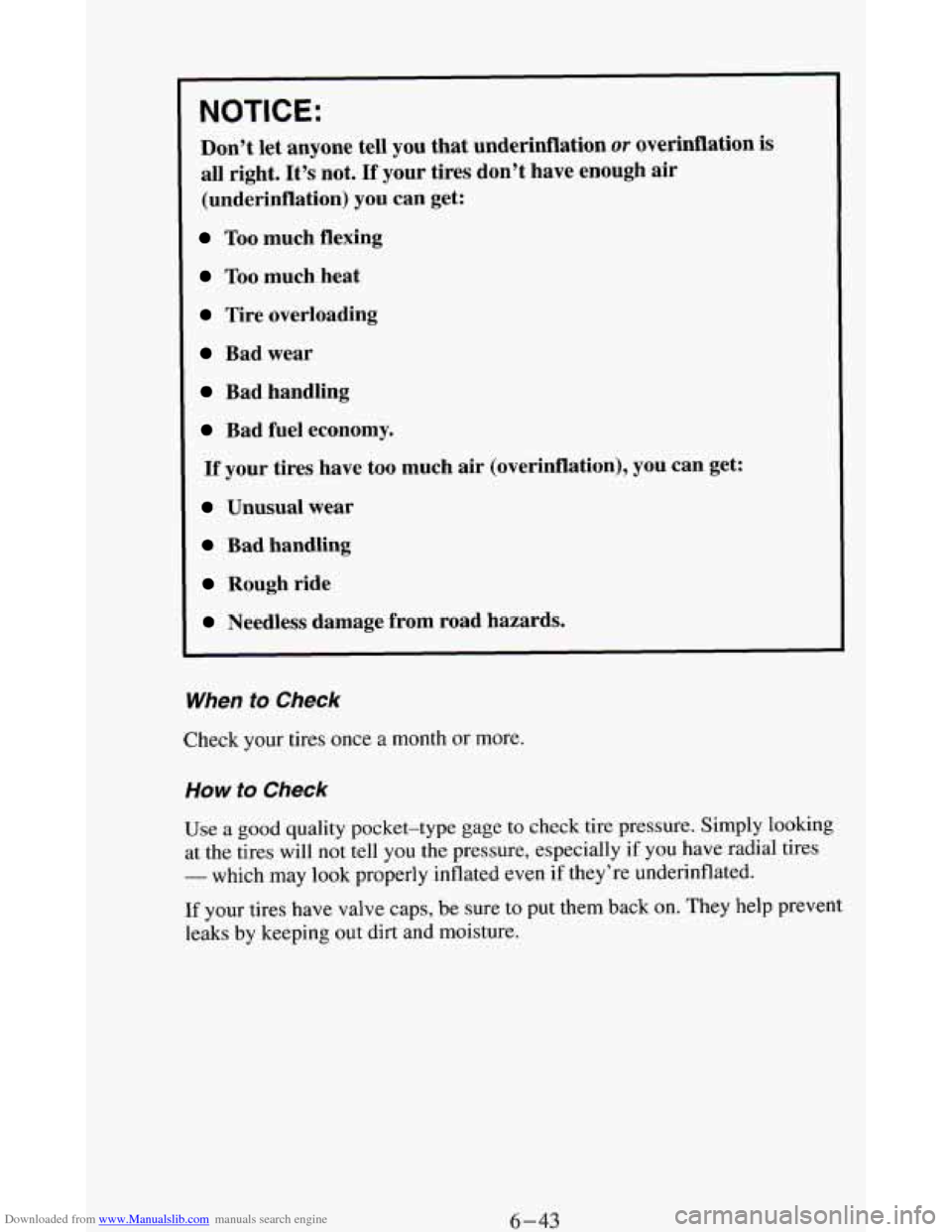
Downloaded from www.Manualslib.com manuals search engine NOTICE:
Don’t let anyone tell you that underinflation or overinflation is
all right. It’s not. If your tires don’t have enough air
(underinflation)
you can get:
Too much flexing
Too much heat
Tire overloading
Bad wear
Bad handling
Bad fuel economy.
If your tires have too much air (overinflation), you can get:
Unusual wear
Bad handling
Rough ride
Needless damage from road hazards.
When to Check
Check your tires once a month or more.
How to Check
Use a good quality pocket-type gage to check tire pressure. Simply looking
at the tires will not tell you the pressure, especially if you have radial tires
- which may look properly inflated even if they’re underinflated.
If your tires have valve caps, be sure to put them back on. They help prevent
leaks by keeping out dirt and moisture.
6-43
Page 280 of 348
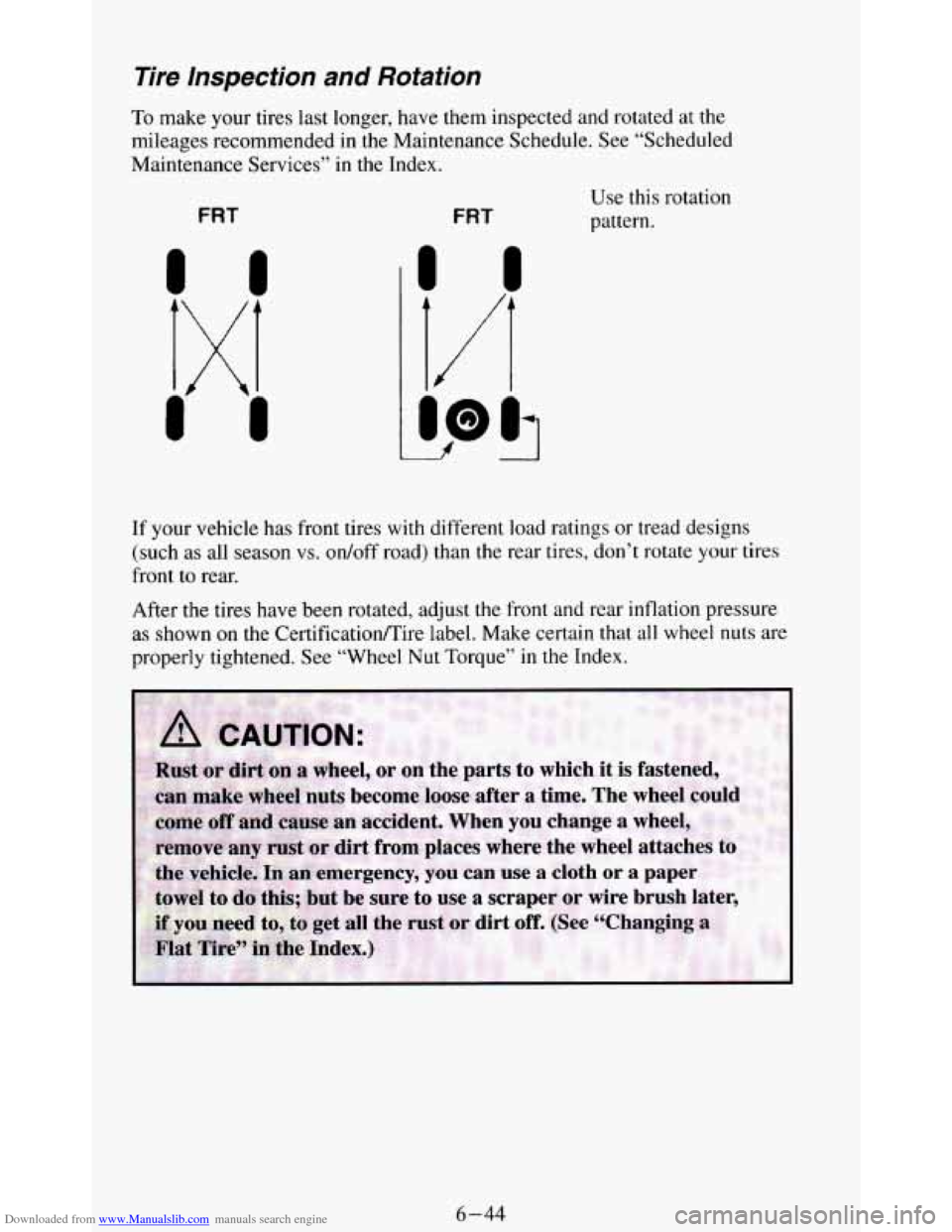
Downloaded from www.Manualslib.com manuals search engine Tire Inspection and Rotation
To make your tires last longer, have them inspected and rotated at the
mileages recommended in the Maintenance Schedule.
See “Scheduled
Maintenance Services’’ in the Index.
FRT FRT
Use this rotation
pattern.
U
If your vehicle has front tires with different load ratings or tread designs
(such as all season
vs. on/off road) than the rear tires, don’t rotate your tires
front to rear.
After the tires have been rotated, adjust
the front and rear inflation pressure
as shown on the CertificationEire label. Make certain that all wheel nuts are
properly tightened. See “Wheel
Nut Torque” in the Index.
6-44
Page 316 of 348
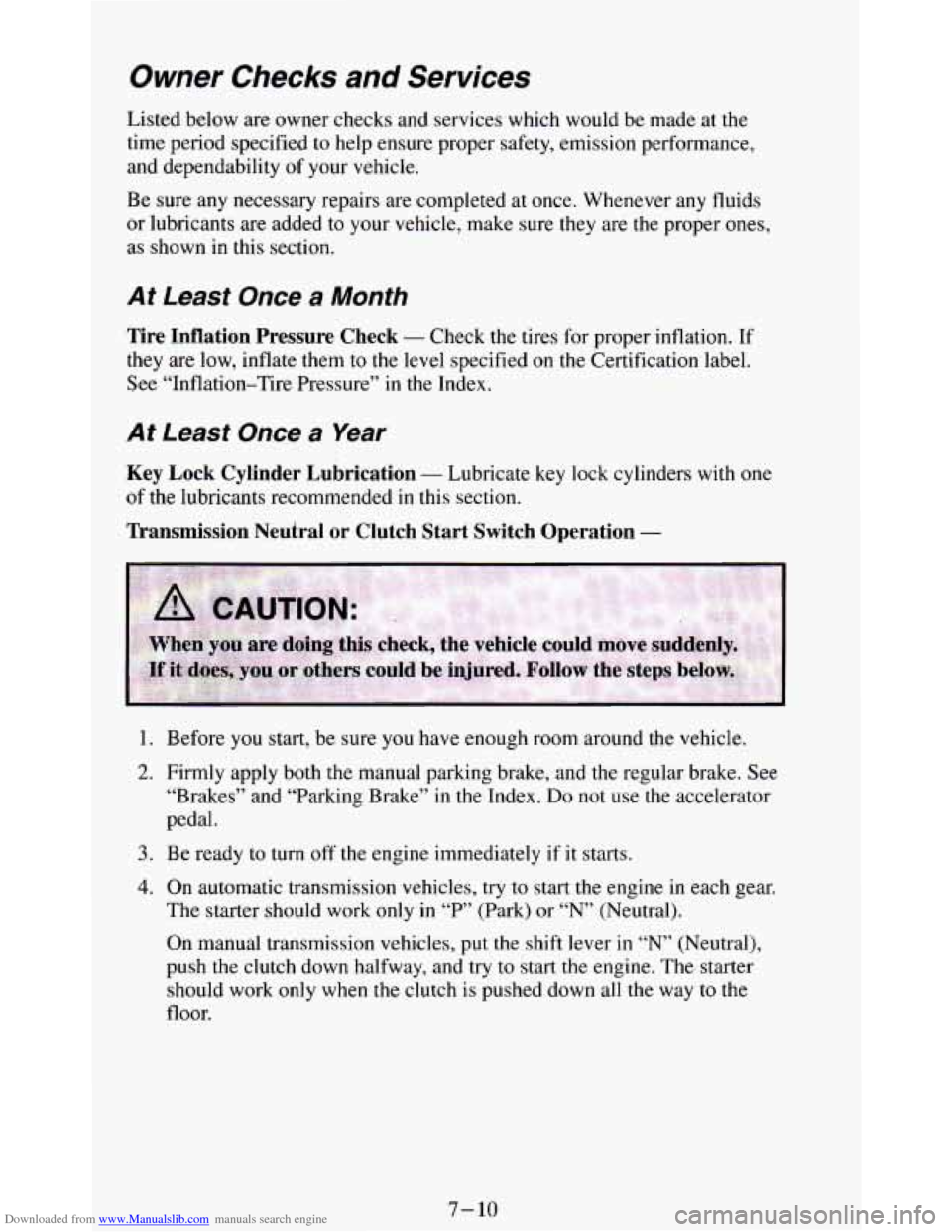
Downloaded from www.Manualslib.com manuals search engine Owner Checks and Services
Listed below are owner checks and services which would be made at the
time period specified to help ensure proper safety, emission performance,
and dependability of your vehicle.
Be sure any necessary repairs are completed at once. Whenever any fluids
or lubricants are added
to your vehicle, make sure they are the proper ones,
as shown in this section.
At Least Once a Month
Tire Inflation Pressure Check - Check the tires for proper inflation. If
they are low, inflate them to the level specified on the Certification label.
See “Inflation-Tire Pressure” in the Index.
At Least Once a Year
Key Lock Cylinder Lubrication - Lubricate key lock cylinders with one
of the lubricants recommended
in this section.
Transmission Neutral or Clutch Start Switch Operation -
1. Before you start, be sure you have enough room around the vehicle.
2. Firmly apply both the manual parking brake, and the regular brake. See
“Brakes” and “Parking Brake” in the Index.
Do not use the accelerator
pedal.
3. Be ready to turn off the engine immediately if it starts.
4. On automatic transmission vehicles, try to start the engine in each gear.
The starter should work
only in “P” (Park) or “N” (Neutral).
On manual transmission vehicles, put the shift lever in “N’ (Neutral),
push the clutch down halfway, and try to start the engine. The starter
should work only when the clutch is pushed down
all the way to the
floor.
7-10
Page 341 of 348
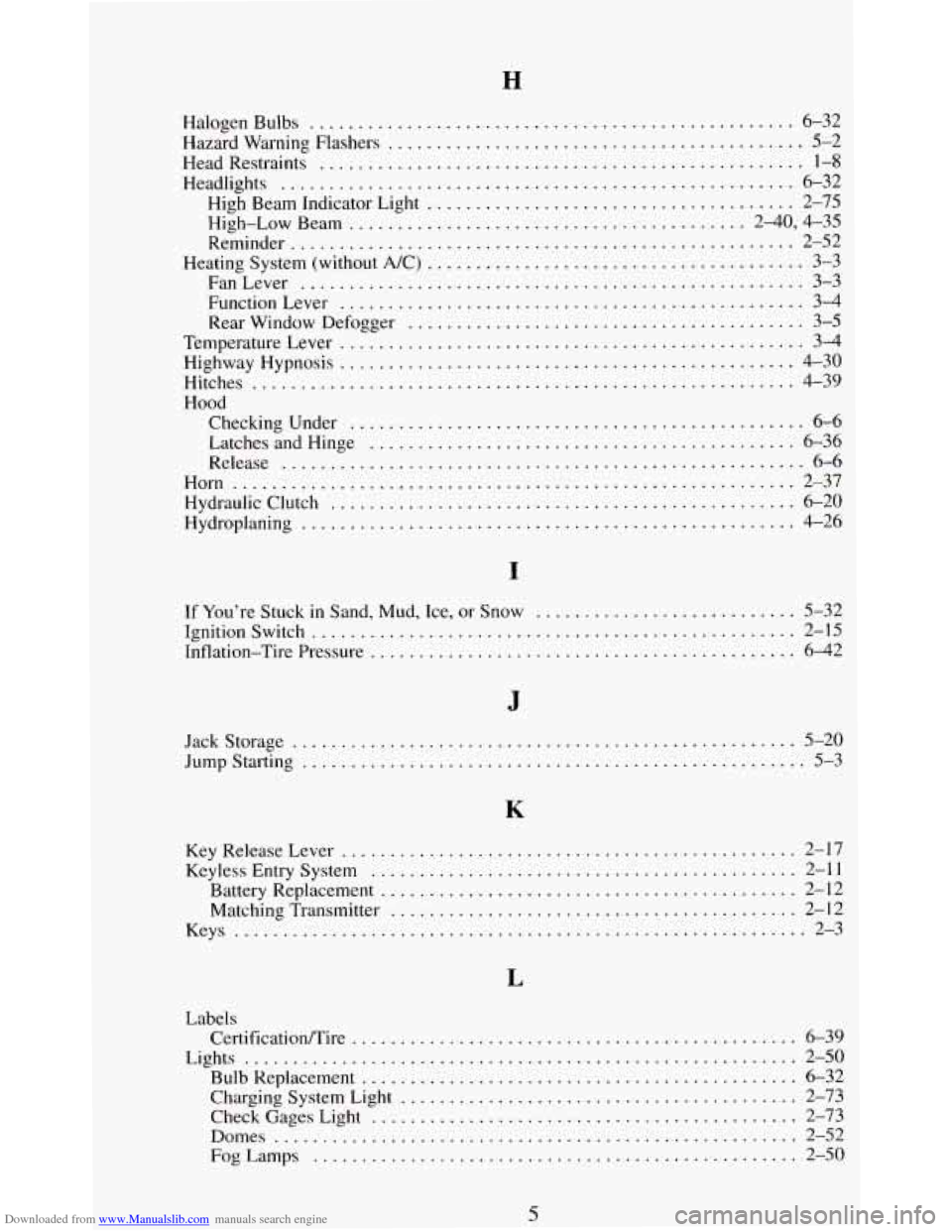
Downloaded from www.Manualslib.com manuals search engine H
HalogenBulbs .................................................. 6-32
Headlights
..................................................... 6-32
Hazard Warning Flashers
........................................... 5-2
Head Restraints
.................................................. 1-8
High Beam indicator Light ...................................... 2-75
High-LowBeam
......................................... 2-40. 4-35
Reminder
.................................................... 2-52
Heating System (without
A/C) ....................................... 3-3
FanLever
.................................................... 3-3
FunctionLever
................................................ 3-4
Rear Window Defogger
......................................... 3-5
Temperature Lever ................................................ 3-4
Highway Hypnosis
............................................... 4-30
Hitches
.................................................... 4-39
Hood Checking Under
............................................... 6-6
LatchesandHinge
............................................ 6-36
Release
...................................................... 6-6
Horn
.......................................................... 2-37
Hydraulic Clutch
................................................ 6-20
Hydroplaning
................................................... 4-26
If You're Stuck in Sand. Mud. Ice. or Snow ........................... 5-32
Ignition Switch
.................................................. 2-15
Inflation-Tire Pressure
............................................ 6-42
Jackstorage
.................................................... 5-20
Jumpstarting
.................................................... 5-3
K
KeyReleaseLever ............................................... 2-17
Keyless Entry System
............................................ 2-11
Battery Replacement
........................................... 2-12
Matching Transmitter
.......................................... 2-12
Keys
........................................................... 2-3
Labels Certification/Tire
.............................................. 6-39
Bulb Keplacetnent
............................................. 6-32
Charging System Light
......................................... 2-73
Check Gages Light
............................................ 2-73
Domes
...................................................... 2-52
FogLamps
.................................................. 2-50
Lights
......................................................... 2-50
5